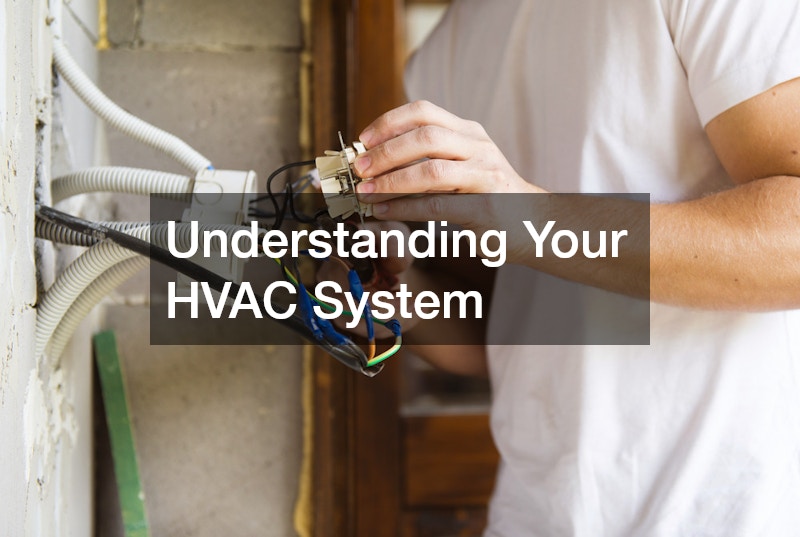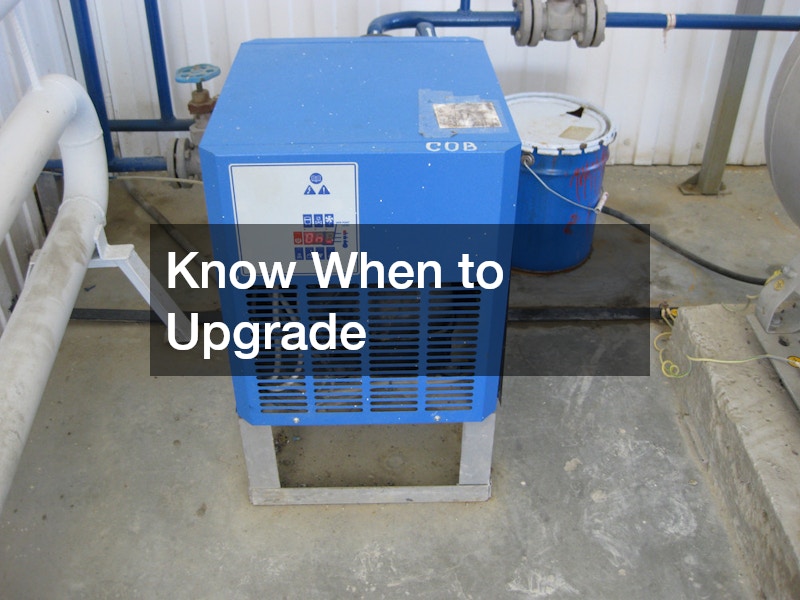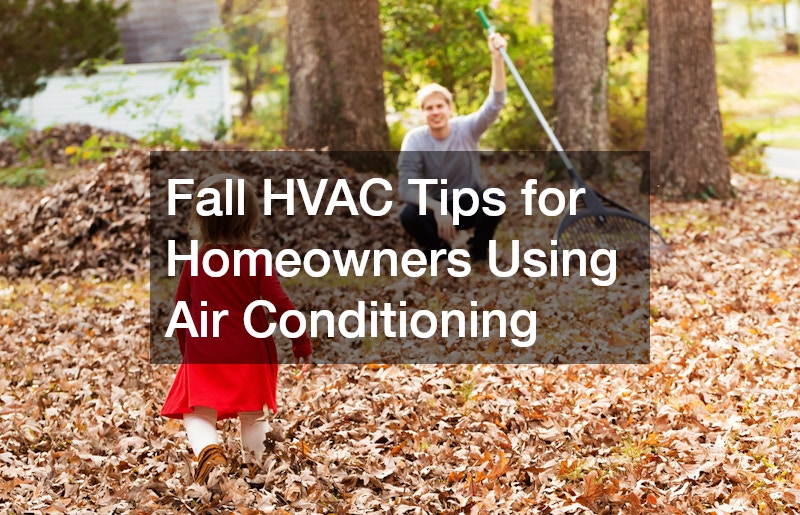Fall HVAC Tips for Homeowners Using Air Conditioning
As the fall season approaches, it’s important to prepare your HVAC system for the changing weather. By following some simple tips and maintenance routines, you can ensure that your heating and cooling system operates efficiently and effectively during the cooler months. In this article, we will discuss various fall HVAC tips to help you maintain your system and get the most out of it. Whether it’s scheduling a professional inspection or changing air filters regularly, taking these steps can prolong the life of your HVAC system and save you money in the long run.
Understanding Your HVAC System

Before diving into fall HVAC tips, it’s essential to understand the basics of your HVAC system. Your HVAC system comprises two main components: the heating unit (furnace or heat pump) and the cooling unit (air conditioner). These work together to regulate the temperature, humidity, and air quality in your home. By knowing how each component functions and their maintenance requirements, you can take better care of your HVAC system and ensure its optimal performance.
When it comes to HVAC maintenance, it’s crucial to hire a reputable AC company or HVAC contractor to handle any repairs or inspections. These professionals have the skills and knowledge to diagnose issues, make necessary repairs, and provide expert advice on maintaining your system. By partnering with a trusted HVAC service provider, you can rest assured that your system is in good hands and will operate efficiently throughout the fall and beyond.
Additionally, familiarizing yourself with fall HVAC tips will help you address common issues that may arise during the season. From checking thermostat settings to cleaning the outdoor unit, these simple tasks can prevent costly repairs and ensure your system runs smoothly when you need it most. By staying proactive and attentive to your HVAC system’s needs, you can enjoy a comfortable and energy-efficient home environment all year round.
Schedule a Professional Inspection
When it comes to fall HVAC tips, scheduling a professional inspection should be at the top of your list. Contacting a local AC repairs company or HVAC contractor to perform a comprehensive check-up on your system can identify any potential issues before they escalate. A professional inspection can detect problems such as leaks, faulty components, or clogged filters that may impact your system’s performance.
During the inspection, an HVAC technician will also ensure that your system is clean and properly calibrated for optimal efficiency. They can clean the internal components, lubricate moving parts, and perform any necessary repairs to keep your system running smoothly. By investing in a professional inspection, you can catch small issues early and avoid costly breakdowns that could leave you without heating or cooling when you need it most.
In addition to inspecting your HVAC system, a professional HVAC contractor can provide valuable maintenance tips and recommendations to help you care for your system between visits. By following their advice and staying on top of routine maintenance tasks, you can extend the life of your HVAC system and maximize its performance throughout the fall and beyond.
Change Air Filters Regularly
One of the simplest yet most effective fall HVAC tips is changing your air filters regularly. Dirty or clogged filters can restrict airflow, reduce efficiency, and strain your system, leading to increased energy consumption and potential breakdowns. By replacing your filters every 1-3 months, depending on usage and the type of filter, you can improve indoor air quality and maintain optimal HVAC performance.
When changing your air filters, be sure to use the correct size and type recommended by your HVAC manufacturer. This will ensure a proper fit and maximum filtration efficiency, trapping dust, dirt, pollen, and other airborne particles that can affect your system’s operation. Additionally, clean filters can help prevent allergens and pollutants from circulating in your home, creating a healthier and more comfortable living environment for you and your family.
In addition to changing air filters, consider upgrading to high-efficiency filters or installing a whole-house air purifier to further enhance indoor air quality and protect your HVAC system. These upgrades can reduce maintenance needs, extend the life of your system, and provide added health benefits for those with allergies or respiratory issues. By investing in clean air solutions, you can enjoy cleaner air and improved HVAC performance year-round.
Clean the Outdoor Unit

Another essential fall HVAC tip is cleaning the outdoor unit of your air conditioning system. Over time, leaves, debris, and dirt can accumulate around the outdoor condenser unit, blocking airflow and hindering heat exchange. This can cause your system to work harder, reduce efficiency, and lead to premature wear and tear on the components. By clearing away debris and cleaning the unit regularly, you can improve airflow and help your system operate more efficiently.
To clean the outdoor unit, start by turning off the power to the system to avoid any electrical hazards. Remove any leaves, branches, or debris from around the unit and gently hose down the exterior to remove dirt and grime. You can also carefully clean the fins with a soft brush or vacuum to remove any buildup that may be obstructing airflow. By maintaining a clean outdoor unit, you can ensure proper heat exchange and prevent costly repairs down the line.
In addition to cleaning the outdoor unit, it’s essential to trim back any vegetation or foliage around the unit to allow for proper airflow and ventilation. Ensure that there is at least 2 feet of clearance around the unit to prevent airflow restrictions and ensure optimal performance. By keeping the outdoor unit clean and free of obstructions, you can prolong the life of your HVAC system and enjoy consistent comfort throughout the fall and beyond.
Check Thermostat Settings
When preparing your HVAC system for the fall season, don’t forget to check your thermostat settings. As the weather cools down, you’ll want to adjust the temperature settings on your thermostat to ensure comfort and energy efficiency. Consider setting your thermostat to a lower temperature during the day when you’re away from home to save on energy costs, and raising it slightly in the evening for optimal comfort.
For added convenience and energy savings, you may want to invest in a programmable or smart thermostat that allows you to set temperature schedules based on your preferences and lifestyle. These devices can help you save energy by automatically adjusting the temperature when you’re not home or asleep, reducing energy waste and lowering your utility bills. By optimizing your thermostat settings, you can maintain a comfortable indoor environment while saving money on heating and cooling costs.
In addition to adjusting your thermostat settings, consider scheduling regular HVAC maintenance to ensure that your system is operating efficiently and effectively. An HVAC contractor can calibrate your thermostat, check for proper operation, and make any necessary adjustments to improve performance. By staying proactive with your thermostat maintenance, you can avoid temperature inconsistencies, reduce energy consumption, and prolong the life of your HVAC system.
Seal Windows and Doors
As the temperatures drop in the fall, it’s essential to seal any drafts or air leaks around windows and doors to prevent heat loss and maintain indoor comfort. Cracks, gaps, and leaks can allow cold air to enter your home and warm air to escape, causing your HVAC system to work harder to maintain the desired temperature. By sealing these openings with weatherstripping or caulking, you can improve energy efficiency and reduce heating costs.
Start by inspecting windows and doors for any gaps or cracks that may be letting cold air in. Apply weatherstripping to the edges of windows and doors to create a tight seal and prevent drafts. Additionally, use caulking to seal any larger gaps or holes where air may be escaping. This simple and cost-effective solution can help you maintain a consistent indoor temperature and reduce the strain on your HVAC system during the fall and winter months.
In addition to sealing windows and doors, consider adding insulation to attics, crawl spaces, and basements to further improve energy efficiency and comfort. Proper insulation can help regulate indoor temperatures, reduce energy loss, and enhance the effectiveness of your HVAC system. By taking these steps to seal and insulate your home with HVAC repair, you can create a more energy-efficient and comfortable living space for you and your family.
Review Insulation Levels

When it comes to fall HVAC tips, reviewing insulation levels in your home is crucial for maintaining energy efficiency and comfort. Proper insulation helps regulate indoor temperatures, reduce heat loss, and prevent energy waste, allowing your HVAC system to operate more efficiently. By checking and upgrading insulation levels in key areas of your home, you can enhance comfort and lower heating and cooling costs throughout the fall and winter.
Start by inspecting the insulation in attics, walls, floors, and crawl spaces to ensure that it meets recommended R-values for your climate zone. Adding insulation to these areas can help retain heat in the winter and keep your home cool in the summer, reducing the workload on your HVAC system year-round. Consider hiring a cooling contractor or insulation specialist to assess your insulation needs and recommend upgrades for optimal energy efficiency.
In addition to adding insulation, seal any gaps or leaks in ductwork to prevent conditioned air from escaping and improve system performance. Leaky ducts can waste energy and compromise indoor air quality, leading to higher utility bills and poor HVAC efficiency. By addressing insulation and ductwork issues, you can create a more comfortable and energy-efficient home environment for you and your family.
Consider Duct Cleaning
Another important fall HVAC tip is considering duct cleaning to improve indoor air quality and system efficiency. Over time, dust, dirt, allergens, and mold can accumulate in your ductwork, reducing airflow, and contaminating the air you breathe. By having your ducts professionally cleaned, you can remove these pollutants, improve system performance, and enhance indoor air quality for a healthier living environment.
Air duct cleaning involves removing debris and buildup from ducts, vents, and registers to eliminate contaminants and improve airflow throughout your home. This process can reduce allergens, prevent musty odors, and enhance heating and cooling system efficiency. By investing in duct cleaning, you can enjoy cleaner air, improved system performance, and prolonged HVAC system life.
When scheduling duct cleaning services, be sure to hire a reputable AC repair company or HVAC service provider with the necessary expertise and equipment to perform the job effectively. Professional technicians can thoroughly clean your ductwork, inspect for leaks or damage, and recommend additional air quality solutions to enhance your indoor environment. By prioritizing duct cleaning as part of your fall HVAC tips, you can breathe easier, reduce allergens, and enjoy a healthier home environment this fall.
Be Mindful of Humidity Levels
As the seasons change, it’s essential to be mindful of humidity levels in your home with ac installation services to maintain comfort and indoor air quality. Proper humidity levels can affect your HVAC system’s performance, energy efficiency, and overall comfort, helping you stay healthy and comfortable throughout the fall and winter. By monitoring and adjusting humidity levels as needed, you can create a more comfortable and healthy living environment for you and your family.
To control indoor humidity, consider using a humidifier or dehumidifier to maintain optimal levels between 30 to 50%. This can prevent issues such as mold growth, mildew, condensation, and discomfort associated with dry or humid air. By keeping humidity levels in check, you can improve indoor air quality, reduce allergens, and ensure that your HVAC system operates efficiently and effectively.
In addition to using humidifiers or dehumidifiers, ensure proper ventilation in your home to circulate air and prevent moisture buildup. Use exhaust fans in kitchens and bathrooms to remove excess humidity, open windows when weather permits, and maintain a clean and clutter-free environment to promote airflow. By staying mindful of humidity levels with these fall HVAC tips and taking steps to control them, you can create a healthier and more comfortable indoor environment this fall and beyond.
Monitor Energy Usage
Monitoring your energy usage is another essential fall HVAC tip to help you save money, reduce energy waste, and maximize system efficiency. By tracking your energy consumption and identifying areas of improvement, you can make informed decisions to lower your utility bills, minimize environmental impact, and ensure that your HVAC system operates efficiently. Consider implementing energy-saving practices and upgrades to optimize your system performance and reduce energy costs.
Start by tracking your heating and cooling costs over time to identify patterns and opportunities for savings. Use programmable thermostats, energy-efficient lighting, and smart home devices to reduce energy usage and lower your utility bills. Additionally, consider upgrading to high-efficiency HVAC systems, appliances, and insulation to further enhance energy efficiency and comfort in your home.
By monitoring your energy usage and making strategic changes to reduce consumption, you can save money, lower your carbon footprint, and create a more sustainable home environment. Take advantage of energy-saving fall HVAC tips and resources available from your HVAC contractors with budget-friendly air conditioning repair techniques or contact a local utility company to improve efficiency and comfort throughout the fall and beyond.
Know When to Upgrade

Knowing when to upgrade your HVAC system is essential for maintaining comfort, efficiency, and reliability in your home. As your system ages, it may become less efficient, require frequent repairs, or struggle to keep up with your heating and cooling needs. By recognizing the signs of an outdated or failing system, you can make informed decisions about upgrading to a newer, more energy-efficient model.
Consider factors such as the age of your HVAC system, its repair history, energy costs, and comfort levels to determine if an upgrade is necessary. Newer HVAC systems offer advanced features, improved energy efficiency, and enhanced performance that can save you money and improve comfort in your home. Consult with your HVAC service provider or cooling contractor to assess your system and recommend upgrades that meet your needs and budget.
When it’s time for air conditioning repair, consider investing in high-efficiency models, smart thermostats, and zoning systems to maximize comfort and savings. These upgrades can help you reduce energy consumption, lower utility bills, and enjoy a more comfortable living environment year-round. By staying proactive and knowing when to upgrade, you can ensure that your HVAC system meets your needs and provides reliable performance for years to come.
Fall is an ideal time to prepare your HVAC system for the changing weather and ensure optimal performance throughout the season. By following these fall HVAC tips, you can take proactive steps to maintain your system, improve efficiency, and save money on energy costs. Whether it’s scheduling a professional inspection, changing air filters regularly, or sealing windows and doors, these simple tasks can make a significant difference in your HVAC system’s operation and longevity.
